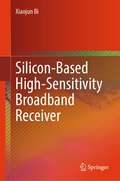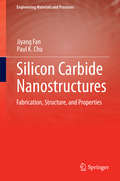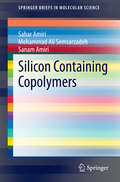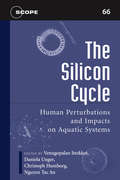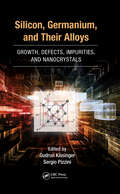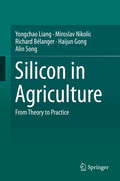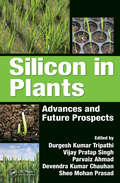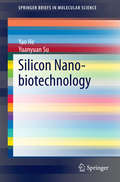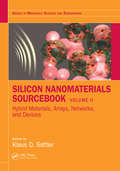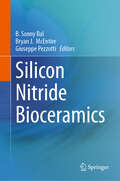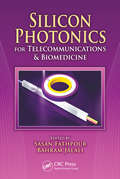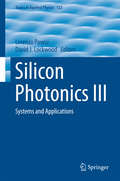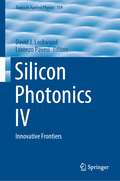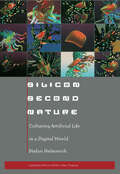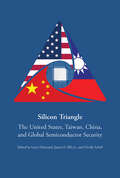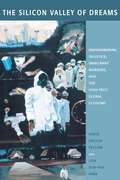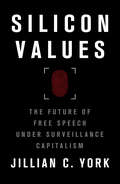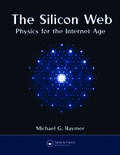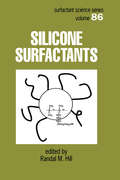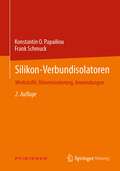- Table View
- List View
Silicon-Based High-Sensitivity Broadband Receiver
by Xiaojun BiThis book presents various design theories and methodologies for silicon-based high-sensitivity broadband receivers, including millimeter-wave radiometer chips and photoelectric receivers, which are core elements in imaging systems, data centers, and telecommunication infrastructures. As a key module in application systems, the high-sensitivity broadband receiver, not only attracts the attention of engineers and researchers in the radio-frequency and optoelectronic fields, but also garners significant interest from other disciplines, including optics, communications, and security. The book introduces various silicon-based critical design technologies aim to overcome the limitations inherent in silicon devices, distinctly enhancing sensitivity with a broad bandwidth. These innovative design methodologies, initially proposed and subsequently validated through meticulous measurements, represent a pioneering contribution. The book provides readers with detailed insights into design intricacies and considerations. Its audience includes undergraduate and graduate students with a specific interest in RF/optoelectronic receiver technology, along with researchers and engineers engaged in the study of imaging systems, data centers, or other communication applications.
Silicon Carbide Nanostructures
by Jiyang Fan Paul K. ChuThis book brings together the most up-to-date information on the fabrication techniques, properties, and potential applications of low dimensional silicon carbide (SiC) nanostructures such as nanocrystallites, nanowires, nanotubes, and nanostructured films. It also summarizes the tremendous achievements acquired during the past three decades involving structural, electronic, and optical properties of bulk silicon carbide crystals. SiC nanostructures exhibit a range of fascinating and industrially important properties, such as diverse polytypes, stability of interband and defect-related green to blue luminescence, inertness to chemical surroundings, and good biocompatibility. These properties have generated an increasing interest in the materials, which have great potential in a variety of applications across the fields of nanoelectronics, optoelectronics, electron field emission, sensing, quantum information, energy conversion and storage, biomedical engineering, and medicine. SiC is also a most promising substitute for silicon in high power, high temperature, and high frequency microelectronic devices. Recent breakthrough pertaining to the synthesis of ultra-high quality SiC single-crystals will bring the materials closer to real applications. Silicon Carbide Nanostructures: Fabrication, Structure, and Properties provides a unique reference book for researchers and graduate students in this emerging field. It is intended for materials scientists, physicists, chemists, and engineers in microelectronics, optoelectronics, and biomedical engineering.
Silicon Containing Copolymers
by Sahar Amiri Mohammad Ali Semsarzadeh Sanam AmiriSilicones have unique properties including thermal oxidative stability, low temperature flow, high compressibility, low surface tension, hydrophobicity and electric properties. These special properties have encouraged the exploration of alternative synthetic routes of well defined controlled microstructures of silicone copolymers, the subject of this Springer Brief. The authors explore the synthesis and characterization of notable block copolymers. Recent advances in controlled radical polymerization techniques leading to the facile synthesis of well-defined silicon based thermo reversible block copolymers are described along with atom transfer radical polymerization (ATRP), a technique utilized to develop well-defined functional thermo reversible block copolymers. The brief also focuses on Polyrotaxanes and their great potential as stimulus-responsive materials which produce poly (dimethyl siloxane) (PDMS) based thermo reversible block copolymers.
The Silicon Cycle: Human Perturbations and Impacts on Aquatic Systems (SCOPE Series #66)
by Daniela Unger Nguyen Tac An Venugopalan Ittekkot Christoph HumborgSilicon is among the most abundant elements on earth. It plays a key but largely unappreciated role in many biogeochemical processes, including those that regulate climate and undergird marine food webs. The Silicon Cycle is the first book in more than 20 years to present a comprehensive overview of the silicon cycle and issues associated with it. The book summarizes the major outcomes of the project Land-Ocean Interactions: Silica Cycle, initiated by the Scientific Community on Problems of the Environment (SCOPE) of the International Council of Scientific Unions (ICSU). It tracks the pathway of silicon from land to sea and discusses its biotic and abiotic modifications in transit as well as its cycling in the coastal seas. Natural geological processes in combination with atmospheric and hydrological processes are discussed, as well as human perturbations of the natural controls of the silicon cycle.
Silicon Earth: Introduction to Microelectronics and Nanotechnology, Second Edition
by John D. CresslerWe are in the center of the most life-changing technological revolution the Earth has ever known. In little more than 65 years, an eye-blink in human history, a single technological invention has launched the proverbial thousand ships, producing the most sweeping and pervasive set of changes ever to wash over humankind; changes that are reshaping the very core of human existence, on a global scale, at a relentlessly accelerating pace. And we are just at the very beginning. Silicon Earth: Introduction to Microelectronics and Nanotechnology introduces readers with little or no technical background to the marvels of microelectronics and nanotechnology, using straightforward language, an intuitive approach, minimal math, and lots of pictures. The general scientific and engineering underpinnings of microelectronics and nanotechnology are described, as well as how this new technological revolution is transforming a broad array of interdisciplinary fields, and civilization as a whole. Special "widget deconstruction" chapters address the inner workings of ubiquitous micro/nano-enabled pieces of technology, such as smartphones, flash drives, and digital cameras. Completely updated and upgraded to full color, the Second Edition: Includes new material on the design of electronic systems, the future of electronics, and the societal impact of micro/nanotechnology Provides new widget deconstructions of cutting-edge tech gadgets like the GPS-enabled smartwatch Adds end-of-chapter study questions and hundreds of new color photos Silicon Earth: Introduction to Microelectronics and Nanotechnology, Second Edition is a pick-up-and-read-cover-to-cover book for those curious about the micro/nanoworld, as well as a classroom-tested, student-and-professor-approved text ideal for an undergraduate-level university course. Lecture slides, homework examples, a deconstruction project, and discussion threads are available via an author-maintained website.
Silicon, Germanium, and Their Alloys: Growth, Defects, Impurities, and Nanocrystals
by Gudrun Kissinger Sergio PizziniDespite the vast knowledge accumulated on silicon, germanium, and their alloys, these materials still demand research, eminently in view of the improvement of knowledge on silicon-germanium alloys and the potentialities of silicon as a substrate for high-efficiency solar cells and for compound semiconductors and the ongoing development of nanodevic
Silicon in Agriculture
by Yongchao Liang Miroslav Nikolic Richard Bélanger Haijun Gong Alin SongThis book mainly presents the current state of knowledge on the use of of Silicon (Si) in agriculture, including plants, soils and fertilizers. At the same time, it discusses the future interdisciplinary research that will be needed to further our knowledge and potential applications of Si in agriculture and in the environmental sciences in general. As the second most abundant element both on the surface of the Earth's crust and in soils, Si is an agronomically essential or quasi-essential element for improving the yield and quality of crops. Addressing the use of Si in agriculture in both theory and practice, the book is primarily intended for graduate students and researchers in various fields of the agricultural, biological, and environmental sciences, as well as for agronomic and fertilizer industry experts and advisors. Dr. Yongchao Liang is a full professor at the College of Environmental and Resource Sciences of the Zhejiang University, Hangzhou, China. Dr. Miroslav Nikolic is a research professor at the Institute for Multidisciplinary Research of the University of Belgrade, Serbia. Dr. Richard Bélanger is a full professor at the Department of Plant Pathology of the Laval University, Canada and holder of a Canada Research Chair in plant protection. Dr. Haijun Gong is a full professor at College of Horticulture, Northwest A&F University, China. Dr. Alin Song is an associate professor at Institute of Agricultural Resources and Regional Planning, Chinese Academy of Agricultural Sciences, Beijing, China.
Silicon in Plants: Advances and Future Prospects
by Sheo Prasad Vijay Singh Durgesh Tripathi Devendra Chauhan Parvaiz AhmadIn the present era, rapid industrialization and urbanization has resulted in unwanted physiological, chemical, and biological changes in the environment that have harmful effects on crop quality and productivity. This situation is further worsened by the growing demand for food due to an ever increasing population. This forces plant scientists and agronomists to look forward for alternative strategies to enhance crop production and produce safer, healthier foods. Biotic and abiotic stresses are major constraints to crop productivity and have become an important challenge to agricultural scientists and agronomists due to the fact that both stress factors considerably reduce agriculture production worldwide per year. Silicon has various effects on plant growth and development, as well as crop yields. It increases photosynthetic activity, creates better disease resistance, reduces heavy metal toxicity, improves nutrient imbalance, and enhances drought tolerance. Silicon in Plants: Advances and Future Prospects presents the beneficial effects of silicon in improving productivity in plants and enhancing the capacity of plants to resist stresses from environmental factors. It compiles recent advances made worldwide in different leading laboratories concerning the role of silicon in plant biology in order to make these outcomes easily accessible to academicians, researchers, industrialists, and students. Nineteen chapters summarize information regarding the role of silicon in plants, their growth and development, physiological and molecular responses, and responses against the various abiotic stresses.
Silicon Nano-biotechnology
by Yao He Yuanyuan SuThis book reviews the latest advances in the development of silicon nano-biotechnology for biological and biomedical applications, which include biosensing, bioimaging, and cancer therapy. In this book, newly developed silicon nano-biotechnology and its biomedical applications are systematically introduced. For instance, fluorescent silicon nanoparticles, serving as novel high-performance biological nanoprobes, are superbly suited to real-time and long-term bioimaging. Silicon nanowire-based sensing platform is especially capable of sensitive, specific, and multiplexed detection of various biological species. Silicon-based nanocarriers with ultra-high drug-loading capacity are highly efficacious for in vitro and in vivo cancer therapies. This book is intended for readers who are interested in the design of functional silicon nanostructures and their biological and biomedical applications. It uses silicon nanoparticles and silicon nanowires as models and discusses topics ranging from their synthesis to their biological applications, the goal being to highlight these exciting achievements as starting points in the field of silicon nano-biotechnology. Yao He is a Professor at Institute of Functional Nano&Soft Materials (FUNSOM), Soochow University, China. Yuanyuan Su is an Associate Professor at Institute of Functional Nano&Soft Materials (FUNSOM), Soochow University, China.
Silicon Nanomaterials Sourcebook: Low-Dimensional Structures, Quantum Dots, and Nanowires, Volume One (Series in Materials Science and Engineering)
by Klaus D. SattlerThis comprehensive tutorial guide to silicon nanomaterials spans from fundamental properties, growth mechanisms, and processing of nanosilicon to electronic device, energy conversion and storage, biomedical, and environmental applications. It also presents core knowledge with basic mathematical equations, tables, and graphs in order to provide the reader with the tools necessary to understand the latest technology developments. From low-dimensional structures, quantum dots, and nanowires to hybrid materials, arrays, networks, and biomedical applications, this Sourcebook is a complete resource for anyone working with this materials: Covers fundamental concepts, properties, methods, and practical applications. Focuses on one important type of silicon nanomaterial in every chapter. Discusses formation, properties, and applications for each material. Written in a tutorial style with basic equations and fundamentals included in an extended introduction. Highlights materials that show exceptional properties as well as strong prospects for future applications. Klaus D. Sattler is professor physics at the University of Hawaii, Honolulu, having earned his PhD at the Swiss Federal Institute of Technology (ETH) in Zurich. He was honored with the Walter Schottky Prize from the German Physical Society, and is the editor of the sister work also published by Taylor & Francis, Carbon Nanomaterials Sourcebook, as well as the acclaimed multi-volume Handbook of Nanophysics.
Silicon Nanomaterials Sourcebook: Hybrid Materials, Arrays, Networks, and Devices, Volume Two (Series in Materials Science and Engineering)
by Klaus D. SattlerThis comprehensive tutorial guide to silicon nanomaterials spans from fundamental properties, growth mechanisms, and processing of nanosilicon to electronic device, energy conversion and storage, biomedical, and environmental applications. It also presents core knowledge with basic mathematical equations, tables, and graphs in order to provide the reader with the tools necessary to understand the latest technology developments. From low-dimensional structures, quantum dots, and nanowires to hybrid materials, arrays, networks, and biomedical applications, this Sourcebook is a complete resource for anyone working with this materials: Covers fundamental concepts, properties, methods, and practical applications. Focuses on one important type of silicon nanomaterial in every chapter. Discusses formation, properties, and applications for each material. Written in a tutorial style with basic equations and fundamentals included in an extended introduction. Highlights materials that show exceptional properties as well as strong prospects for future applications. Klaus D. Sattler is professor physics at the University of Hawaii, Honolulu, having earned his PhD at the Swiss Federal Institute of Technology (ETH) in Zurich. He was honored with the Walter Schottky Prize from the German Physical Society, and is the editor of the sister work also published by Taylor & Francis, Carbon Nanomaterials Sourcebook, as well as the acclaimed multi-volume Handbook of Nanophysics.
Silicon Nitride Bioceramics
by B. Sonny Bal Bryan J. McEntire Giuseppe PezzottiThis book offers a comprehensive exploration of silicon nitride biomaterials, encompassing both established and emerging applications. Key topics include a foundational overview of biomaterials, followed by an in-depth examination of silicon nitride's structure, bulk properties, processing techniques, surface chemistry, and its critical functionalities: osteoconductivity and antipathogenicity. The text delves into silicon nitride biocomposites and coatings, exploring their potential in various fields. Dedicated chapters address the use of silicon nitride in spinal surgery and total joint arthroplasty, providing valuable insights. Additionally, a critical comparison between silicon nitride and zirconia-toughened alumina is presented. The book concludes with a discussion of silicon nitride's promising future applications within dentistry and other emerging fields. This comprehensive resource serves as an ideal reference for ceramic scientists, students, orthopedic and neurosurgeons, and professionals in the orthopedic implant industry seeking to expand their knowledge of silicon nitride biomaterials and their diverse applications. This book also: Provides the latest research on and applications of silicon nitride biomaterials for spine surgery and additive manufacturing Broadens reader understanding of silicon nitride composites and the antimicrobial properties of silicon nitride Thoroughly details the surface chemistry of silicon nitride in artificial joint environments and future applications of silicon nitride biomaterials
Silicon Photonics Design
by Lukas Chrostowski Michael HochbergFrom design and simulation through to testing and fabrication, this hands-on introduction to silicon photonics engineering equips students with everything they need to begin creating foundry-ready designs. In-depth discussion of real-world issues and fabrication challenges ensures that students are fully equipped for careers in industry. Step-by-step tutorials, straightforward examples, and illustrative source code fragments guide students through every aspect of the design process, providing a practical framework for developing and refining key skills. Offering industry-ready expertise, the text supports existing PDKs for CMOS UV-lithography foundry services (OpSIS, ePIXfab, imec, LETI, IME and CMC) and the development of new kits for proprietary processes and clean-room based research. Accompanied by additional online resources to support students, this is the perfect learning package for senior undergraduate and graduate students studying silicon photonics design, and academic and industrial researchers involved in the development and manufacture of new silicon photonics systems.
Silicon Photonics for Telecommunications and Biomedicine
by Sasan Fathpour Bahram JalaliGiven silicon's versatile material properties, use of low-cost silicon photonics continues to move beyond light-speed data transmission through fiber-optic cables and computer chips. Its application has also evolved from the device to the integrated-system level. A timely overview of this impressive growth, Silicon Photonics for Telecommunications
Silicon Photonics III
by Lorenzo Pavesi David J. LockwoodThis book is volume III of a series of books on silicon photonics. It reports on the development of fully integrated systems where many different photonics component are integrated together to build complex circuits. This is the demonstration of the fully potentiality of silicon photonics. It contains a number of chapters written by engineers and scientists of the main companies, research centers and universities active in the field. It can be of use for all those persons interested to know the potentialities and the recent applications of silicon photonics both in microelectronics, telecommunication and consumer electronics market.
Silicon Photonics IV: Innovative Frontiers (Topics in Applied Physics #139)
by David J. Lockwood Lorenzo PavesiThis fourth book in the series Silicon Photonics gathers together reviews of recent advances in the field of silicon photonics that go beyond already established and applied concepts in this technology. The field of research and development in silicon photonics has moved beyond improvements of integrated circuits fabricated with complementary metal–oxide–semiconductor (CMOS) technology to applications in engineering, physics, chemistry, materials science, biology, and medicine. The chapters provided in this book by experts in their fields thus cover not only new research into the highly desired goal of light production in Group IV materials, but also new measurement regimes and novel technologies, particularly in information processing and telecommunication. The book is suited for graduate students, established scientists, and research engineers who want to update their knowledge in these new topics.
Silicon Polymers
by Aziz M. MuzafarovModern Synthetic and Application Aspects of Polysilanes: An Underestimated Class of Materials?, by A. Feigl, A. Bockholt, J. Weis, and B. Rieger; * Conjugated Organosilicon Materials for Organic Electronics and Photonics, by Sergei A. Ponomarenko and Stephan Kirchmeyer; * Polycarbosilanes Based on Silicon-Carbon Cyclic Monomers, by E.Sh. Finkelshtein, N.V. Ushakov, and M.L. Gringolts; * New Synthetic Strategies for Structured Silicones Using B(C6F5)3, by Michael A. Brook, John B. Grande, and François Ganachaud; * Polyhedral Oligomeric Silsesquioxanes with Controlled Structure: Formation and Application in New Si-Based Polymer Systems, by Yusuke Kawakami, Yuriko Kakihana, Akio Miyazato, Seiji Tateyama, and Md. Asadul Hoque;
Silicon Second Nature: Culturing Artificial Life in a Digital World, Updated With a New Preface
by Stefan HelmreichSilicon Second Nature takes us on an expedition into an extraordinary world where nature is made of bits and bytes and life is born from sequences of zeroes and ones. Artificial Life is the brainchild of scientists who view self-replicating computer programs—such as computer viruses—as new forms of life. Anthropologist Stefan Helmreich's look at the social and simulated worlds of Artificial Life—primarily at the Santa Fe Institute, a well-known center for studies in the sciences of complexity—introduces readers to the people and programs connected with this unusual hybrid of computer science and biology.When biology becomes an information science, when DNA is downloaded into virtual reality, new ways of imagining "life" become possible. Through detailed dissections of the artifacts of Artifical Life, Helmreich explores how these novel visions of life are recombining with the most traditional tales told by Western culture. Because Artificial Life scientists tend to see themselves as masculine gods of their cyberspace creations, as digital Darwins exploring frontiers filled with primitive creatures, their programs reflect prevalent representations of gender, kinship, and race, and repeat origin stories most familiar from mythical and religious narratives.But Artificial Life does not, Helmreich says, simply reproduce old stories in new software. Much like contemporary activities of cloning, cryonics, and transgenics, the practice of simulating and synthesizing life in silico challenges and multiplies the very definition of vitality. Are these models, as some would claim, actually another form of the real thing? Silicon Second Nature takes Artifical Life as a symptom and source of our mutating visions of life itself.
Silicon Triangle: The United States, Taiwan, China, and Global Semiconductor Security
by Larry Diamond James O. Ellis Jr. Orville SchellThe United States, Taiwan, and China are bound within a "silicon triangle." Semiconductors link our geopolitics, our ongoing economic prosperity, and our technological competitiveness. This book draws on the deliberations of a multidisciplinary Hoover Institution–Asia Society working group of technologists, economists, military strategists, industry players, and regional policy experts to contemplate the dynamic global supply chain in semiconductors—one in which US industry faces growing vulnerabilities, China aggressively promotes home-grown semiconductor mastery, and Taiwan finds itself with a crucial monopoly on high-end logic chips sought by buyers globally. Silicon Triangle seeks to present a balanced view of how policies of the United States and its partners around semiconductors can increase the resilience of shared supply chains—and contribute to deterring conflict in the Taiwan Strait.
The Silicon Valley of Dreams: Environmental Injustice, Immigrant Workers, and the High-Tech Global Economy (Critical America #31)
by David Pellow Lisa Sun-Hee ParkExamines the environmental racism at the foundation of the Silicon Valley economyNext to the nuclear industry, the largest producer of contaminants in the air, land, and water is the electronics industry. Silicon Valley hosts the highest density of Superfund sites anywhere in the nation and leads the country in the number of temporary workers per capita and in workforce gender inequities. Silicon Valley offers a sobering illustration of environmental inequality and other problems that are increasingly linked to the globalization of the world's economies. In The Silicon Valley of Dreams, the authors take a hard look at the high-tech region of Silicon Valley to examine environmental racism within the context of immigrant patterns, labor markets, and the historical patterns of colonialism. One cannot understand Silicon Valley or the high-tech global economy in general, they contend, without also understanding the role people of color play in the labor force, working in the electronic industry's toxic environments. These toxic work environments produce chemical pollution that, in turn, disrupts the ecosystems of surrounding communities inhabited by people of color and immigrants. The authors trace the origins of this exploitation and provide a new understanding of the present-day struggles for occupational health and safety. The Silicon Valley of Dreams will be critical reading for students and scholars in ethnic studies, immigration, urban studies, gender studies, social movements, and the environment, as well as activists and policy-makers working to address the needs of workers, communities, and industry.
Silicon Values: The Future of Free Speech Under Surveillance Capitalism
by Jillian C. YorkHow Google, Facebook and Amazon threaten our DemocracyWhat is the impact of surveillance capitalism on our right to free speech? The Internet once promised to be a place of extraordinary freedom beyond the control of money or politics, but today corporations and platforms exercise more control over our ability to access information and share knowledge to a greater extent than any state. From the online calls to arms in the thick of the Arab Spring to the contemporary front line of misinformation, Jillian York charts the war over our digital rights. She looks at both how the big corporations have become unaccountable censors, and the devastating impact it has had on those who have been censored.In Silicon Values, leading campaigner Jillian York, looks at how our rights have become increasingly undermined by the major corporations desire to harvest our personal data and turn it into profit. She also looks at how governments have used the same technology to monitor citizens and threatened our ability to communicate. As a result our daily lives, and private thoughts, are being policed in an unprecedented manner. Who decides the difference between political debate and hate speech? How does this impact on our identity, our ability to create communities and to protest? Who regulates the censors? In response to this threat to our democracy, York proposes a user-powered movement against the platforms that demands change and a new form of ownership over our own data.
The Silicon Web: Physics for the Internet Age
by Michael G. RaymerThe technology behind computers, fiber optics, and networks did not originate in the minds of engineers attempting to build an Internet. The Internet is a culmination of intellectual work by thousands of minds spanning hundreds of years. We have built concept upon concept and technology upon technology to arrive at where we are today, in a world co
Silicone Dispersions (Surfactant Science)
by Yihan LiuSilicone is an important class of materials used in applications that range from industrial assembly to everyday consumer products. Silicones are often delivered and synthesized in dispersion forms, the most common being liquid-in-liquid (emulsion), solid-in-liquid (suspension), air-in-liquid (foam) and solid-in air (powder). This book compiles a carefully selected number of topics that are essential to the understanding, creative design and production of silicone dispersions. As such, it provides the first unified description of silicone dispersions in the literature.
Silicone Surfactants
by Randal M. HillThe book offers a good summary of the field for all scientists who are interested in synthesis, properties, and the application of silicone surfactants." ---Molecular Chemistry and Physics. "Serves as a comprehensive introduction to the preparation, uses, and physical chemistry of silicone surfactants--focusing on silicone polyoxyalkylene copolymers that are surface active in both aqueous and nonaqueous systems. Covers applications in the manufacture of polyurethane foam, coatings, wetting agents, fabric finishes, and polymer surface modifiers."
Silikon-Verbundisolatoren: Werkstoffe, Dimensionierung, Anwendungen
by Konstantin O. Papailiou Frank SchmuckIn dem Buch stellen die Autoren das Thema Silikon-Verbundisolatoren umfassend dar. Sie beschreiben die mechanischen und elektrotechnischen Grundlagen, berücksichtigen neueste Entwicklungen und gehen auf alle wesentlichen Aspekte ein: von der Auswahl der Werkstoffe über die Dimensionierung bis zur Anwendung in Hochspannungsnetzen. Die Autoren sind Pioniere auf dem Gebiet der Verbundisolatoren und legen höchsten Wert auf die Praxisrelevanz ihres Wissens. So eignet sich der Band als Einführung in das Thema ebenso wie als Nachschlagewerk für die Praxis.
